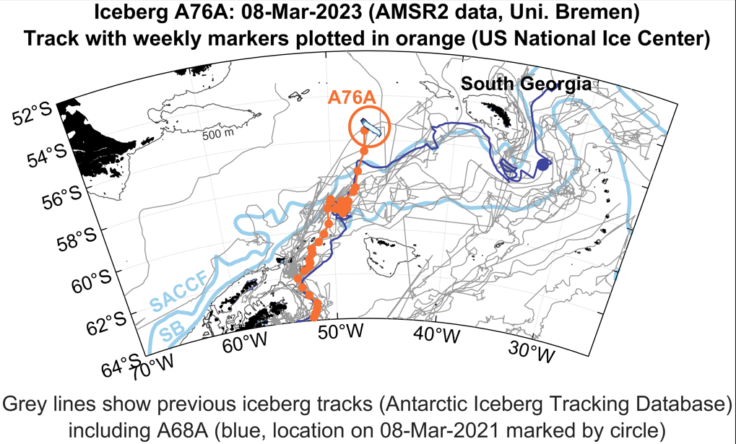According to The British Antarctic Survey (BAS), two colossal icebergs named A81 and A76 are on the move and will have a significant impact on the ocean ecosystems that support the diverse marine wildlife found in the Antarctic region.
On the plus side, as the icebergs melts, they will release a large amount of nutrients, which may benefit the growth of microscopic plants like phytoplankton at the bottom of oceanic food webs. The downside is that this large-scale melting dumps a lot of freshwater into the ocean, lowering salinity levels and making the waters unsuitable for many phytoplankton and the zooplankton that feed on them. These effects could then spread up the food chain, affecting fish, birds, seals, and whales.
The A81 iceberg has spun around and is heading south after breaking free from the ice shelf. A81 is expected to follow in the footsteps of previous icebergs swept westward by the powerful Antarctic Coastal Current. The British Antarctic Survey (BAS) is closely following the icebergs and has released the following information:
A81 Iceberg
- Measures in at 1550 km2 approximately the size of Greater London
- Calved from the Brunt Ice Shelf on the 22nd of January 2023 and has traveled approximately 150km south following the coastline
- Formed from the Chasm-1 crack which lay dormant until 2012
- Expected to follow the Antarctic Coastal Current around the Weddell Sea as with previous icebergs
#Copernicus for polar monitoring
The large #A81 #iceberg which calved from the Brunt Shelf in Antarctica🇦🇶 continues to move along the continent’s northwestern coast
⬇️Timelapse of #Sentinel2🇪🇺🛰️ images showing A81 drifting more than 150 km in 45 days between January & March pic.twitter.com/ziCzPvfoGd
— Copernicus EU (@CopernicusEU) March 13, 2023
A76 iceberg
- Measuring in at approximately 3200 km2 and is shaped like a giant ironing board
- Calved from the Filchner-Ronne Ice shelf in mid-May 2021 and was first spotted by BAS oceanographer Keith Makinson
- Broke into three chunks with the largest heading towards Shag Rocks and the island of South Georgia
- Potential for large disruption to local wildlife as it releases massive volumes of freshwater and nutrients as well as disrupting ocean currents and blocking wildlife foraging routes


































































